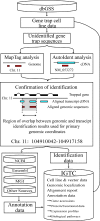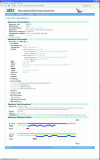The International Gene Trap Consortium Website: a portal to all publicly available gene trap cell lines in mouse
- PMID: 16381950
- PMCID: PMC1347459
- DOI: 10.1093/nar/gkj097
The International Gene Trap Consortium Website: a portal to all publicly available gene trap cell lines in mouse
Abstract
Gene trapping is a method of generating murine embryonic stem (ES) cell lines containing insertional mutations in known and novel genes. A number of international groups have used this approach to create sizeable public cell line repositories available to the scientific community for the generation of mutant mouse strains. The major gene trapping groups worldwide have recently joined together to centralize access to all publicly available gene trap lines by developing a user-oriented Website for the International Gene Trap Consortium (IGTC). This collaboration provides an impressive public informatics resource comprising approximately 45 000 well-characterized ES cell lines which currently represent approximately 40% of known mouse genes, all freely available for the creation of knockout mice on a non-collaborative basis. To standardize annotation and provide high confidence data for gene trap lines, a rigorous identification and annotation pipeline has been developed combining genomic localization and transcript alignment of gene trap sequence tags to identify trapped loci. This information is stored in a new bioinformatics database accessible through the IGTC Website interface. The IGTC Website (www.genetrap.org) allows users to browse and search the database for trapped genes, BLAST sequences against gene trap sequence tags, and view trapped genes within biological pathways. In addition, IGTC data have been integrated into major genome browsers and bioinformatics sites to provide users with outside portals for viewing this data. The development of the IGTC Website marks a major advance by providing the research community with the data and tools necessary to effectively use public gene trap resources for the large-scale characterization of mammalian gene function.
Figures



Similar articles
-
International Gene Trap Project: towards gene-driven saturation mutagenesis in mice.Curr Pharm Biotechnol. 2009 Feb;10(2):221-9. doi: 10.2174/138920109787315006. Curr Pharm Biotechnol. 2009. PMID: 19199955 Review.
-
BayGenomics: a resource of insertional mutations in mouse embryonic stem cells.Nucleic Acids Res. 2003 Jan 1;31(1):278-81. doi: 10.1093/nar/gkg064. Nucleic Acids Res. 2003. PMID: 12520002 Free PMC article.
-
Essential validation of gene trap mouse ES cell lines: a test case with the gene Ttrap.Int J Dev Biol. 2009;53(7):1045-51. doi: 10.1387/ijdb.092859lv. Int J Dev Biol. 2009. PMID: 19598121
-
High-throughput trapping of secretory pathway genes in mouse embryonic stem cells.Nucleic Acids Res. 2006 Feb 13;34(3):e25. doi: 10.1093/nar/gnj026. Nucleic Acids Res. 2006. PMID: 16478711 Free PMC article.
-
A review of current large-scale mouse knockout efforts.Genesis. 2010 Feb;48(2):73-85. doi: 10.1002/dvg.20594. Genesis. 2010. PMID: 20095055 Review.
Cited by
-
Mixture of differentially tagged Tol2 transposons accelerates conditional disruption of a broad spectrum of genes in mouse embryonic stem cells.Nucleic Acids Res. 2012 Jul;40(13):e97. doi: 10.1093/nar/gks262. Epub 2012 Mar 24. Nucleic Acids Res. 2012. PMID: 22447447 Free PMC article.
-
Developmental and adult phenotyping directly from mutant embryonic stem cells.Proc Natl Acad Sci U S A. 2007 Mar 13;104(11):4455-60. doi: 10.1073/pnas.0609277104. Epub 2007 Mar 2. Proc Natl Acad Sci U S A. 2007. PMID: 17360545 Free PMC article.
-
The UCSC Genome Browser database: update 2010.Nucleic Acids Res. 2010 Jan;38(Database issue):D613-9. doi: 10.1093/nar/gkp939. Epub 2009 Nov 11. Nucleic Acids Res. 2010. PMID: 19906737 Free PMC article.
-
Loss of mouse Ikbkap, a subunit of elongator, leads to transcriptional deficits and embryonic lethality that can be rescued by human IKBKAP.Mol Cell Biol. 2009 Feb;29(3):736-44. doi: 10.1128/MCB.01313-08. Epub 2008 Nov 17. Mol Cell Biol. 2009. PMID: 19015235 Free PMC article.
-
Impaired mitochondrial complex I function as a candidate driver in the biological stress response and a concomitant stress-induced brain metabolic reprogramming in male mice.Transl Psychiatry. 2020 Jun 1;10(1):176. doi: 10.1038/s41398-020-0858-y. Transl Psychiatry. 2020. PMID: 32488052 Free PMC article.
References
-
- Waterston R.H., Chinwalla A.T., Cook L.L., Delehaunty K.D., Fewell G.A., Fulton L.A., Fulton R.S., Graves T.A., Hillier L.W., Lindblad-Toh K., et al. Initial sequencing and comparative analysis of the mouse genome. Nature. 2002;420:520–562. - PubMed
-
- Sung Y.H., Lee H.-W., Song J. Functional genomics approach using mice. J. Biochem. Mol. Biol. 2004;37:122–132. - PubMed
-
- Nolan P.M. Generation of mouse mutants as a tool for functional genomics. Pharmacogenomics. 2000;1:243–255. - PubMed
-
- Stanford W.L., Cohn J.B., Cordes S.P. Gene-trap mutagenesis: past, present and beyond. Nature Rev. Genet. 2001;2:756–768. - PubMed
-
- Branda C.S., Dymecki S.M. Talking about a revolution: The impact of site-specific recombinases on genetic analyses in mice. Dev. Cell. 2004;6:7–28. - PubMed
Publication types
MeSH terms
Substances
Grants and funding
LinkOut - more resources
Full Text Sources
Other Literature Sources
Molecular Biology Databases
Research Materials

